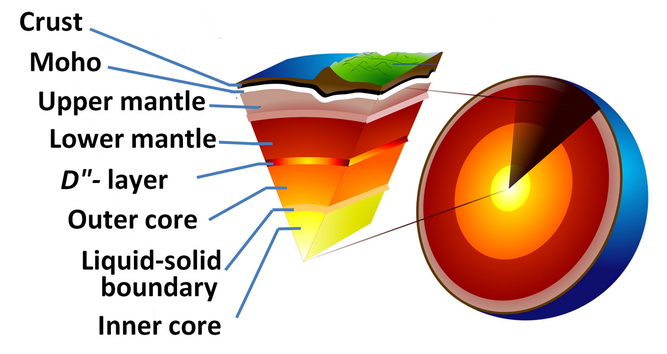And what causes these massive intraplate rupturings? Something deep within the Earth. More than that we don't know.
這種跨板塊大地震是怎么發(fā)生的?原因在地球深處。更多的情況我們就不知道了。
By the 1960s scientists had grown sufficiently frustrated by how little they understood of the Earth's interior that they decided to try to do something about it. Specifically, they got the idea to drill through the ocean floor (the continental crust was too thick) to the Moho discontinuity and to extract a piece of the Earth's mantle for examination at leisure. The thinking was that if they could understand the nature of the rocks inside the Earth, they might begin to understand how they interacted, and thus possibly be able to predict earthquakes and other unwelcome events.
到20世紀(jì)60年代,科學(xué)家們對地球內(nèi)部的事兒了解得太少,覺得很傷心,因此決心要采取一點(diǎn)措施。具體來說,他們想在海床上(大陸上的地殼太厚)鉆個(gè)孔,一直鉆到莫霍面,取出一塊地幔樣品來慢慢研究。他們認(rèn)為,只要能搞清地球內(nèi)部巖石的性質(zhì),也許就能開始了解它們的相互作用,從而能預(yù)測地震和其他不受歡迎的事件。

The project became known, all but inevitably, as the Mohole and it was pretty well disastrous. The hope was to lower a drill through 14,000 feet of Pacific Ocean water off the coast of Mexico and drill some 17,000 feet through relatively thin crustal rock. Drilling from a ship in open waters is, in the words of one oceanographer, "like trying to drill a hole in the sidewalks of New York from atop the Empire State Building using a strand of spaghetti." Every attempt ended in failure. The deepest they penetrated was only about 600 feet. The Mohole became known as the No Hole. In 1966, exasperated with ever-rising costs and no results, Congress killed the project.
這個(gè)項(xiàng)目幾乎肯定會(huì)被命名為“莫霍鉆探”,它簡直是災(zāi)難性的。他們希望把鉆頭伸進(jìn)墨西哥近海4000多米深的太平洋海水,然后再往下鉆5000多米,穿透比較薄的地殼巖石。從外海的一條船上搞鉆探,用一位海洋學(xué)家的話來說,“就像試圖從帝國大廈頂上用一根意大利式細(xì)面條在紐約的人行道上鉆個(gè)孔”。一切努力都以失敗告終。他們充其量只深入到大約180米的地方。莫霍鉆探最后被稱之為“無法鉆探”。1966年,由于成本不斷上升,不見成果,國會(huì)又氣又惱,取消了這個(gè)項(xiàng)目。
來源:可可英語 http://www.ccdyzl.cn/Article/201709/525651.shtml











